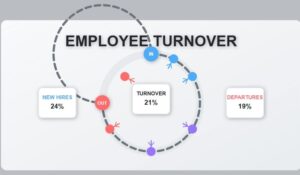Enterprise surveys that are well-thought-out can help businesses discover employee insights credibly and efficiently. Managements can use these insights to improve the organizational culture. But what makes enterprise surveys truly effective?
This article explores the role of workplace surveys in enhancing organizational culture and outlines how HubEngage, with its comprehensive communication channels, is the best choice to implement this strategy.
Enterprise Surveys Definition
Workplace surveys are structured questionnaires designed to gather feedback from employees on various aspects of their work environment, including company policies, leadership, communication, and overall satisfaction. These surveys can be in the form of online survey platforms, face-to-face interviews, or form-based questionnaires. The questions within enterprise surveys can cover a range of topics, including employee satisfaction, workplace safety, career development opportunities, and overall organizational effectiveness. Additionally, these surveys also allow employees to express their opinions freely and fearlessly.
When designing workplace surveys, it is crucial to ensure that the questions are clear, concise, and relevant. The survey should be structured in a way that allows employees to provide honest and thoughtful responses. By using a mix of closed-ended and open-ended questions, organizations can gather both quantitative and qualitative data, providing a comprehensive understanding of employee perceptions.
Moreover, it is essential to consider the anonymity of the survey respondents. By assuring employees that their responses will remain confidential, organizations can encourage honest feedback without fear of repercussions. This anonymity fosters a safe environment for employees to express their opinions and concerns freely.
The Importance of Regular Employee Feedback
Regular employee feedback is a vital component of a thriving organization. By seeking input from employees, organizations demonstrate their commitment to listening to their workforce and valuing their opinions. This fosters a culture of open communication and makes employees feel heard and appreciated.
Furthermore, regular feedback allows organizations to identify areas of improvement, address concerns, and implement changes that positively impact employee engagement and satisfaction. Through enterprise surveys, organizations can gain insights into employee perceptions of their work environment, identify potential issues, and take proactive measures to address them.
Employee feedback also plays a crucial role in shaping organizational policies and practices. By understanding employee perspectives, organizations can make informed decisions that align with their workforce’s needs and aspirations. This collaborative approach to decision-making strengthens employee trust and engagement, leading to a more positive and productive work environment.
Additionally, regular employee feedback helps organizations track progress over time. By conducting workplace surveys at regular intervals, organizations can measure changes in employee satisfaction and engagement, allowing them to evaluate the effectiveness of implemented initiatives and make necessary adjustments.
Workplace surveys are a powerful tool for organizations to gather feedback from employees and enhance their organizational culture. By valuing employee opinions, organizations can foster a culture of open communication, improve employee engagement and satisfaction, and make informed decisions that benefit both the workforce and the organization as a whole.
The Connection Between Workplace Surveys and Organizational Culture
Surveys have a direct impact on an organization’s culture. They let employees express their thoughts, feelings, and concerns, which in turn influences the overall organizational atmosphere. By actively seeking feedback through surveys, organizations demonstrate a commitment to transparency, openness, and inclusivity. This fosters a culture of trust and collaboration, where employees feel comfortable sharing their ideas and opinions.
Furthermore, workplace surveys serve as a powerful tool for organizations to gather valuable insights into their employees’ experiences and perceptions. These insights can help leaders understand the current state of the organizational culture and identify areas that need improvement.
For example, workplace surveys may reveal that employees feel a lack of recognition for their contributions. Armed with this knowledge, leaders can implement initiatives to enhance recognition and appreciation, thereby strengthening the organizational culture.
How Workplace Surveys Shape Culture
Surveys shape culture by giving employees a voice in shaping company policies, initiatives, and processes. When employees feel heard and included, they become more engaged and invested in the organization’s success. The insights gained from workplace surveys enable organizations to identify strengths and areas for improvement, leading to targeted initiatives and actions that align with the overall company culture.
Moreover, surveys provide an opportunity for employees to provide feedback on their experiences with diversity and inclusion within the organization. By collecting data on employees’ perceptions of inclusivity, organizations can identify any gaps or biases that exist and take steps to create a more inclusive culture. This may involve implementing diversity training programs, establishing employee resource groups, or revising recruitment and promotion practices to ensure equal opportunities for all.
The Impact of Feedback on Employee Engagement
Feedback received through workplace surveys plays a crucial role in enhancing employee engagement. By actively seeking feedback, organizations show that they value their employees’ opinions and are committed to making necessary changes. This fosters a sense of ownership and empowerment among employees, driving their engagement and motivation to contribute to the company’s growth.
In addition, surveys can be used to measure employee satisfaction and identify potential areas of dissatisfaction. This information can then be used to develop targeted strategies to improve employee morale and job satisfaction. For example, if a survey reveals that employees are dissatisfied with their work-life balance, the organization can explore flexible work arrangements or wellness programs to address this concern.
Furthermore, workplace surveys can be a powerful tool for recognizing and rewarding employees. By including questions about recognition and rewards in surveys, organizations can gather data on employees’ preferences and use this information to design effective recognition programs. This not only boosts employee morale but also reinforces a positive organizational culture that values and appreciates its employees.
Workplace surveys have a significant impact on organizational culture. They provide a platform for employees to share their thoughts and concerns, shape company policies, and contribute to a culture of trust and collaboration. By actively seeking feedback and acting upon it, organizations can enhance employee engagement, improve the overall employee experience, and create a positive and inclusive workplace culture.
Using Workplace Surveys to Drive Business Growth
Enterprise surveys not only serve to enhance organizational culture but can also be powerful tools for driving business growth. By collecting data and insights from employees, organizations can gain a deep understanding of their workforce and leverage this knowledge to make informed decisions that propel the company forward.
Workplace surveys provide a platform for employees to express their opinions, concerns, and suggestions. This open communication fosters a sense of inclusivity and empowers employees to contribute to the growth and success of the organization. Through enterprise surveys, employees have the opportunity to provide feedback on various aspects of the company, such as leadership, communication, work environment, and employee development.
One of the key benefits of using enterprise surveys is the ability to identify areas of improvement. By analyzing survey responses, organizations can pinpoint specific areas where they may be falling short and take necessary action to address these issues. This could involve implementing new policies, providing additional training and development opportunities, or improving communication channels within the organization.
Enterprise Surveys as Tools for Strategic Planning
Strategic planning is essential for every organization’s growth, and enterprise surveys can play a crucial role in this process. Through surveys, organizations can gather data on employee perceptions, identify areas requiring improvement, and align their strategic initiatives accordingly. This enables organizations to focus their resources and efforts on areas that have a direct impact on business growth.
Surveys can provide valuable insights into employee satisfaction, engagement, and motivation levels. By understanding how employees perceive the company’s vision, mission, and goals, organizations can ensure that their strategic plans are aligned with the needs and aspirations of their workforce. This alignment fosters a sense of purpose and creates a shared vision among employees, ultimately driving business growth.
The Role of Enterprise Surveys in Performance Management
Workplace surveys are a valuable component of performance management. By collecting feedback on employees’ experiences and perceptions, organizations can identify both high-performing employees and areas where individuals or teams may be struggling. This information enables organizations to implement targeted development plans, recognize and reward top performers, and enhance overall productivity.
Through performance-related surveys, organizations can gain insights into the factors that contribute to employee performance, such as job satisfaction, workload, and work-life balance. This data can be used to identify potential barriers to productivity and implement strategies to overcome them. By addressing these barriers, organizations can create an environment that fosters high performance and drives business growth.
Surveys are not just a means of collecting data; they are powerful tools that can drive business growth. By utilizing workplace surveys for strategic planning and performance management, organizations can gain valuable insights, identify areas for improvement, and make informed decisions that propel the company forward. Surveys empower employees to contribute to the growth and success of the organization, creating a culture of continuous improvement and innovation.
Implementing Effective Enterprise Surveys
Implementing enterprise surveys requires careful planning and execution to ensure they deliver actionable insights. To drive employee participation and generate meaningful responses, organizations must follow best practices in survey design and ensure employees understand the value of their feedback.
Enterprise surveys are an essential tool for organizations to gather feedback from employees and make informed decisions. By implementing effective enterprise surveys, organizations can gain valuable insights into employee satisfaction, engagement, and areas for improvement. However, designing and executing surveys that yield accurate and actionable results can be a complex process.
Best Practices for Designing Workplace Surveys
When designing a enterprise survey, it is essential to keep it concise, relevant, and easy to understand. Lengthy and convoluted surveys can lead to survey fatigue and lower response rates. By focusing on key areas of interest and asking clear and straightforward questions, organizations can ensure that employees can provide meaningful responses.
Using a mix of open-ended and multiple-choice questions can provide a comprehensive understanding of employee opinions. Open-ended questions allow employees to express their thoughts easily. And multiple-choice questions offer structured data that can be easily analyzed. Striking the right balance between these question types can help organizations gather both qualitative and quantitative insights.
Organizations should ensure anonymity in responses to enhance honesty and openness. Employees may hesitate to provide honest feedback if they fear repercussions or judgment. By assuring employees that their responses will remain confidential, organizations can create a safe space for employees to share their thoughts and opinions.
Ensuring Employee Participation in Workplace Surveys
Low enterprise survey participation can undermine the effectiveness of the feedback process. To encourage employee participation, organizations can utilize channels like mobile apps, web, email, SMS, and digital signage.
By reaching employees through channels they access regularly, organizations can maximize participation and gather diverse perspectives from across the organization. Mobile apps and web-based surveys can be easily accessed from any smartphone or computer with an internet connection. Email and SMS reminders can be sent to employees to encourage them to complete the survey. And digital signage in common areas can serve as a visual reminder too.
Furthermore, organizations can create incentives to motivate employees to participate in workplace surveys. Offering rewards, like gift cards or extra vacation days or cash, can increase participation rates drastically. By emphasizing the importance of employee feedback and its impact on decision-making, organizations can foster a culture of continuous improvement.
Implementing effective enterprise surveys requires careful consideration of survey design and employee participation strategies. By following best practices and utilizing communication channels and incentives, organizations can gather valuable insights and drive positive change within the company.
Measuring the Impact of Enterprise Surveys
To gauge the effectiveness of enterprise surveys, measure key metrics that impact both organizational culture and business growth. This data allows organizations to fine-tune their survey approach and adapt strategies accordingly.
Key Metrics to Evaluate Survey Effectiveness
Some key metrics organizations can use to evaluate enterprise survey effectiveness include participation rates, response rates, and overall satisfaction scores. By analyzing these metrics, organizations can identify areas for improvement and make necessary adjustments.
Interpreting Survey Results for Actionable Insights
Collecting enterprise survey data is only the first step; it is equally important to interpret the results to gain actionable insights. By analyzing survey responses, organizations can identify recurring themes, patterns, and areas of improvement. This knowledge can reform decision-making processes and drive targeted actions that align with the organization’s goals.
HubEngage provides communication channels like mobile apps, web, email, SMS, and digital signage. You can leverage these channels to conduct and publish enterprise surveys and their insights. Reaching and engaging all employees effectively also become much easier. With its comprehensive suite of tools, HubEngage is the best choice for implementing enterprise surveys and leveraging the valuable insights gained to create a thriving organizational culture and drive sustainable business growth.
Ready to transform your organizational culture and accelerate growth?
Discover the HubEngage Difference
Experience the award-winning HubEngage enterprise Survey and Forms platform. See how our multi-channel capabilities can streamline your communications and enhance employee engagement. With custom branded apps, personalized content, complete automation, multi-language support, and unique gamification features, HubEngage has it all. Don’t miss the opportunity to elevate your internal communications strategy. See a demo today and take the first step towards a more connected and productive workplace.













